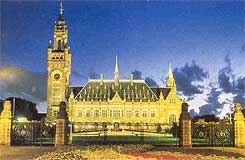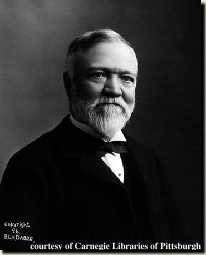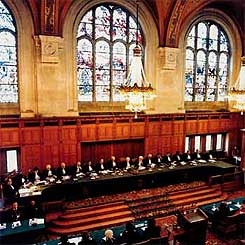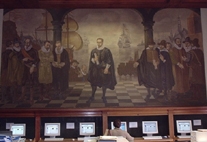 |
| Peace Palace in the Hague, Netherlands (www.holland.com) |
In 1899, the first International Peace Conference in the Hague attracted 100 jurists, politicians, military personnel and diplomats from around the world. At the same time outside of this official "Hague Convention," a large group of activists, writers and scientists gathered to hold pacifist meetings. These war concerns had been expressed a year earlier by Russian Tsar Nicholas II who was troubled by the international arms race, even though Russia itself was one of the world's greatest arms manufacturers. Debate raged about issues of international humanitarian law with respect to the rights of prisoners of war, protection of medical staff in the war zone, the human aspects of war, such as the use of asphyxiating gases and ultimately how to stop the arms race. Several months after these meetings, the Permanent Court of Arbitration (PCA) was established. It was set up in the city of The Hague but needed a more permanent home.
 |
| Andrew Carnegie |
Then along came Andrew Carnegie, the Scottish immigrant who had, in 1901, become the richest man in America, due to the sale of his company, Carnegie Steel. In his essay entitled, “Wealth,” published in North American Review in 1889, this industrialist argued that individual capitalists were duty bound to play a broader cultural and social role and thus improve the world." And one of the ways he chose to improve it was to support the international peace movement by providing a permanent home for the Permanent Court of Arbitration, along with a library on international law. To this end, the Carnegie Endowment for International Peace was established and its first major donation was $1.5 million (worth $30 million today) to start construction on a building that would, in its founder's words, "preferably stand alone and in a park." French architect Louis M. Cordonnier won the international competition to design the PEACE PALACE, while Dutch architect J.A.G. Van der Steur was chosen to amend it. Contributions flooded in from nations around the world eager to have the culture, art, soil and industry of their countries represented. Gifts like the Swiss clock in the bell tower instilled the spirit of collaboration in the very foundation of this impressive building. The PEACE PALACE officially opened in 1913.
Today the PEACE PALACE houses four Institutions: the International Court of Justice, the Peace Palace Library, the Permanent Court of Arbitration and the Hague Academy of International Law.
 |
| International Court of Justice in session. (www.holland.com) |
The International Court of Justice began in 1946 and is the principal judicial organ of the United Nations. It replaced the Permanent Court of International Justice that had operated in the Peace Palace since 1922 and operates under the Charter of the United Nations. Each country operates with their own laws and courts at home but needs a World Court for disputes with, for example, their neighbor. So this International Court plays a dual role: to settle legal disputes between countries using international law, and to give advisory opinions on legal questions referred by international organizations and agencies of the United Nations. The Court is composed of 15 judges of different nationalities who are all appointed by the UN General Assembly and the Security Council on the nomination of individual states or groups of countries (see extra info below). Right now there are 12 cases pending, some of which include: "Armed activities on the territory of the Congo (Democratic Republic of Congo v. Uganda), Territorial and Maritime Dispute (Nicaragua v. Colombia) and "Pulp Mills on the River Uruguay (Argentina v. Uruguay). According to its website, (www.icj-cij.org)… "since 1946 the Court has delivered 92 judgments on disputes concerning inter alia land frontiers and maritime boundaries, territorial sovereignty, the non-use of force, non-interference in the internal affairs of States, diplomatic relations, hostage-taking, the right of asylum, nationality, guardianship, rights of passage and economic rights."
 |
| Painting of Hugo de Groot |
The Peace Palace Library is 102 years old and has grown into one of the world's largest collections specializing in private and public international law, foreign international law, diplomatic history and international relations. This library also houses the GROTIUS COLLECTION, the collection of 17th century Dutchman Hugo de Groot, founder of the science of international law. Visitors are welcome Monday through Friday. To celebrate the centennial in 2004, the Dutch Carnegie Foundation published "THE PEACE PALACE LIBRARY CENTENNIAL EXHIBITION: THE COLLECTION as a MIRROR of the HISTORICAL DEVELOPMENT of INTERNATIONAL LAW." It covers all the periods of international law, "from 17th-century books on the law of the sea and rare treaty series to the electronic documents of the UN online documents service; from arbitration in 1848 to modern arbitration, from International Criminal Law in 1880 to the present International Criminal Court; from Latin texts to French, English and even Chinese law books."
 |
| Scales of Justice |
The Hague Academy of International Law was created in 1923 to provide research and education in the legal systems that govern multinational alliances. It continues to meet the ever growing needs of a swiftly changing world by providing not only its infamous summer courses, but also by adding the external program in the 1960's to extend the knowledge base to Asia, the Americas and now Eastern Europe. As of 2004, a program was set up in the form of intensive refresher seminars in international law, aimed at helping practitioners and others to keep abreast of the constantly evolving rules and principles of transglobal jurisprudence.
NOTE: "The Hague Academy is an original Institution: it is not a University, nor does it work in the same way. It does not have a permanent teaching staff, but its scientific body, the Curatorium, freely calls upon academics, practitioners, diplomats, and other personalities from all over the world whom it considers qualified to give courses, in English or French (with simultaneous interpretation). These courses are given in the form of a series of lectures, on general or special subjects. As a result, the students are always assured of hearing from one of the foremost specialists on each subject. In principle, the courses are then published in the Collected Courses of the Academy of International Law, which now run to more than 300 volumes and are certainly the most important encyclopedic publication on private and public international law."
The fourth Institution housed in the PEACE PALACE in The Hague is the Permanent Court of Arbitration. The PCA is not part of the United Nations system but is an independent intergovernmental organization with its own constituent conventions dating back to the first and second Hague Conventions of 1899 and 1907. It has 106 member states.
The Hague has become synonymous with global justice and peace, mainly because of the PEACE PALACE. Stone edifice? Or hero… you be the judge.
Page created on 6/21/2006 10:41:16 AM
Last edited 1/6/2017 10:23:15 PM
Present composition of the Court
President
Rosalyn Higgins (United Kingdom)
Vice-President
Awn Shawkat Al-Khasawneh (Jordan)
Judges
Raymond Ranjeva (Madagascar)
Shi Jiuyong (China)
Abdul G. Koroma (Sierra Leone)
Gonzalo Parra-Aranguren (Venezuela)
Thomas Buergenthal (United States of America)
Hisashi Owada (Japan)
Bruno Simma (Germany)
Peter Tomka (Slovakia)
Ronny Abraham (France)
Kenneth Keith (New Zealand)
Bernardo Sepúlveda Amor (Mexico)
Mohamed Bennouna (Morocco)
Leonid Skotnikov (Russian Federation )
Registrar
Mr. Philippe Couvreur (Belgium)
